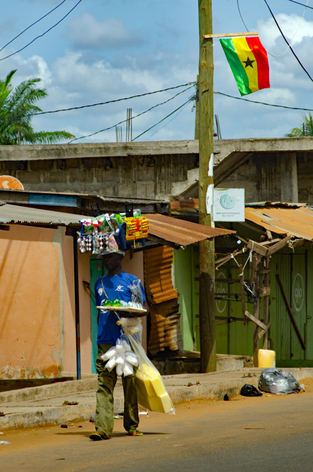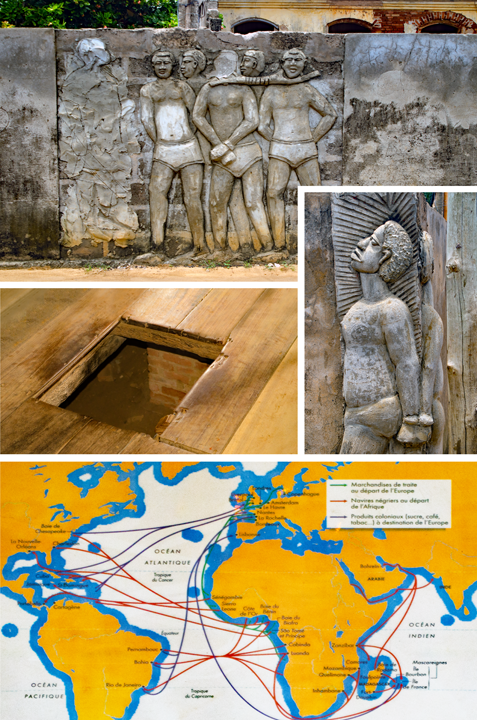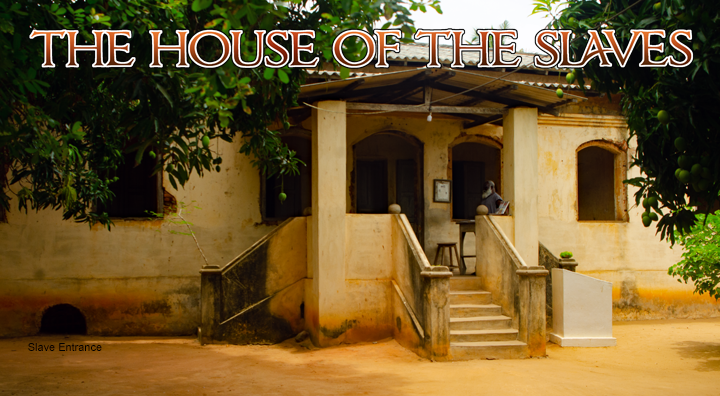 Just a little stroll into country 103, Ghana
Just a little stroll into country 103, Ghana I scheduled the day with my regular chauffeur, Francis. And, right away, he started out with some dessert. I didn’t realize that Lomé, Togo, was right next to the border of Ghana until my driver took me there. I was kind of hoping to get one foot over the border line. Yep, just one foot. That would make Ghana country number 103, a number that even impressed people working at the State Department.
When we arrived at the border, did I have a visa to enter the country?
No.
Did I think to bring my vaccination card that proved I was protected from typhoid, yellow fever, and meningitis?
Another no.
Was there a snowball’s chance in the tropical heat of West Africa that I’d get across the border?
Surprisingly, yes!
Of course, I first had to go to a back room of the Immigrations Office, but there I found a very friendly officer named Wilberforce. He warmed up as soon as I mentioned that I worked with the United States Embassy. He asked how long I planned to be in Ghana. I said, “About fifteen minutes.” That worked for my new buddy.
Francis and I walked into the border town. Instantly, it was easy to see the difference between the two countries. There were not so many cars in Togo’s capital city. There were a lot more motorcycles than cars. But, traffic multiplied greatly on the other side of the international border.
The town in Ghana offered nothing for tourists, but I really doubt if many tourists walked across the border. We walked past the Don’t Mind Your Wife bar and then turned around. A very nice young man asked if he could have a selfie and then a video with me. That’s pretty much my highlights of Ghana, until I got back to the border station.
Wilberforce again greeted me warmly in the back office. Among other things, I asked him what I should eat in Ghana. Everyone, including my Immigration officer, always recommended fufu. I don’t do that. I don't do anything made from the cassava root. But, it’s the national dish of Togo, probably Ghana as well. If you imagine tapioca pudding mixed with instant mashed potato flakes, you sort of have fufu. You pinch a glob, swirl it in a soup with your fingers, and then swallow it whole. I just sits in your stomach for a while, if you don’t throw it up immediately!
 Exterior wall art depictions, the living room trapdoor, and the slave routes to the New World
Exterior wall art depictions, the living room trapdoor, and the slave routes to the New World Then, someone else mentioned food in the Ivory Coast. And, I was asked if I’d tried it. I always love to tell people about the very worst food in the world. It’s akpani, and I was once served it in the Ivory Coast. Okay, there may be some competition here for the very worst food on the planet, but akpani is a very high contender. It was whole, deep-fried, bat complete with head, fangs, wings, and feet. It was served with nothing else. I just had two bats on my plate. Everyone in Immigrations was stunned by this. They’d never heard of akpani. None of them were willing to eat it either!
Before I left, I had to ask Wilberforce if he knew about his name in history. When you’re named after the man who ended slavery in the British Empire, you need to know that much history. Fortunately, my new friend knew that. He might not have known that Wilberforce campaigned against the slave trade for twenty years to get the Slave Trade Act passed in 1807, but he knew why he had a good name.
He escorted me out of Ghana and into Togo without any problems. And then, it only made perfect sense that I was on my way to the House of the Slaves.
If you look back two paragraphs, you see that slavery "ended" in the British Empire in 1807, but the House of Slaves was built by a Scottish slave merchant, John Henry Wood, in 1835. You may be asking yourself, what’s up with that? Well, slavery officially ended in 1807 for the Brits, but if you had no morals or scruples, it was still a lucrative business. The slaves from Nigeria, Niger, Burkina Faso, Benin, Ghana, and Togo, of course, made no money. But, it was very lucrative for the local ruler, Chief Assiakoley of the Adjigo clan, and the slave ship merchants that he worked with. Assiakoley had no intention of giving up on the income. Slave ships continued to come to this home until it was officially closed down in 1857.
The slave house was less than a mile from the beach, but well hidden by lush trees at the time. It was one of the last clandestine slave houses in operation after the official abolishment of slavery. The main floor of the house had a living room and six bedrooms. I’m not sure, however, how anyone managed to sleep in it. In the center of the living room was a trap door to the cellar below, an area not tall enough to stand in. The slaves were forced to squat, sit, or lie in the damp and dark squalor for weeks or months at a time. With hundreds of slaves forced into the space about 20 by 10 yards long, nobody could possibly be comfortable. And, just so you know, none of the slaves entered from the living room area. They had to crawl into the cellar from windows outside of the building. (If you look closely at the photo on the top of the page, you can see the entrance.)
Man’s inhumanity to man is hard to fathom. I climbed into the cellar (from the living room). I experienced how shallow it was. But, I still cannot possibly imagine the anguish, the stench, and the horror of the people who were forced into that hole in the ground.
Of course, the horror didn’t end when the slaves finally left the House of Slaves for the New World. From 1526 to 1867, approximately twelve and a half million captured men, women, and children were put on slave ships to the New World. It was no trip on the Love Boat. More than a million slaves died along the journey. The majority of the slaves on these ships came from West and Central Africa. And, once they arrived in the New World, they were still slaves.
I believe the purpose of history is to teach us about the past, so we don’t repeat the mistakes. The slave trade existed in Togo from the last quarter of the 17th century until the late 19th century. It is so important to see these historic places from the past, learn from them, and share the experience. The House of Slaves has been registered on the UNESCO World Heritage List since 2002. Everyone who comes to Togo should make the pilgrimage to Agbodrafo.



 RSS Feed
RSS Feed